Prime Minister officially launches the new stamp models for Timor-Leste
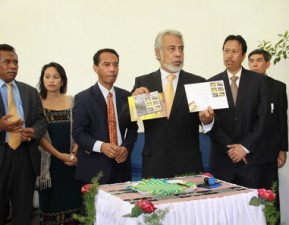
The Prime Minister took the opportunity, during the 35th Anniversary of the Proclamation of Independence, at a ceremony in the National Parliament and accompanied of all that had been present at the official ceremonies, to launch the new stamp models for Timor-Leste.
Kay Rala Xanana Gusmão was pleased with the launch of the Timor-Leste stamps, during the International year of Biodiversity, as a way of presenting the several species of animals representative of the reptiles and amphibians of the country.
The herpetofaunal survey of Timor-Leste was conducted by the Timor Lorosa’e National University, in Díli, in partnership with the Victor Valley College, Victorville, California, as part of an academic program known as the Tropical Research Initiative, and enjoys the high support of the President of the Republic, José Ramos-Horta and the Prime Minister, Kay Rala Xanana Gusmão.
Hinrich Kaiser is the leader of the project and, according to his words, is proud of having been able to contribute to this day, at the same time remembering “the animals represented in these stamps are familiar to all the People of Timor-Leste, where some of them are rooted in the national spirit”.
During the Portuguese and Indonesian administrations, the known herpetofauna consisted only of an extrapolated list of species of other islands in the Lesser Sunda arquipelago.
The present project was initiated in 2009 to determine the true herpetofaunistic biodiversity of the first country of the 21st century, the work in the field has been done in eleven of the thirteen districts, and where several new species have been discovered, awaiting a description/catalogue.
There are six postal stamps: two of 50 cent value (one with a Timor River Frog and another with a Timor Snake-necked Turtle), two of 75 cent value (one with the Island Pitviper and the other with a Timor Monitor) and two of 1 dollar value (one with a Saltwater crocodile and another with the Bronzeback Serpent).
Timor Frog Limnonectes timorensis
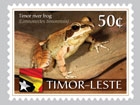 The genus Limnonectes contains over fifty species, distributed across the Indo-Malayan Archipelago, and this is its single representative known from Timor Island. While many other members of the genus have rough, warty skin, the Timor river frog has extremely smooth skin, with the few warts present confined to the flanks of the body beneath a pair of distinctive ridges that separate the dorsum from the flanks. A large, alert, big-eyed frog, the river frog has powerful hind-limbs and can leap a considerable distance to escape a predator. The long toes of the hind-feet are partially webbed for swimming.
The genus Limnonectes contains over fifty species, distributed across the Indo-Malayan Archipelago, and this is its single representative known from Timor Island. While many other members of the genus have rough, warty skin, the Timor river frog has extremely smooth skin, with the few warts present confined to the flanks of the body beneath a pair of distinctive ridges that separate the dorsum from the flanks. A large, alert, big-eyed frog, the river frog has powerful hind-limbs and can leap a considerable distance to escape a predator. The long toes of the hind-feet are partially webbed for swimming.
Timor Turtle Chelodina timorensis
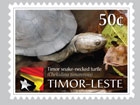 The Timor snake-necked turtle is likely endemic to Timor-Leste, and it is apparently found nowhere else in the world other than Lake Ira Lalaro, Lautem District. It is believed to be most closely related to the snake-necked turtles on Roti Island, of the southwestern tip of West Timor (Indonesia). Snake-necked turtles are an Australo-Papuan group of carnivorous freshwater turtles, that possess extremely long necks, longer than their own bodies. Prey consists of fish, crustaceans and molluscs. The presence of this turtle in only a single lake makes a very strong argument for strict conservation measures to prevent its exploitation or extinction. There currently exists some controversy over the scientific name of this turtle. We here follow the name used in the original description of this turtle.
The Timor snake-necked turtle is likely endemic to Timor-Leste, and it is apparently found nowhere else in the world other than Lake Ira Lalaro, Lautem District. It is believed to be most closely related to the snake-necked turtles on Roti Island, of the southwestern tip of West Timor (Indonesia). Snake-necked turtles are an Australo-Papuan group of carnivorous freshwater turtles, that possess extremely long necks, longer than their own bodies. Prey consists of fish, crustaceans and molluscs. The presence of this turtle in only a single lake makes a very strong argument for strict conservation measures to prevent its exploitation or extinction. There currently exists some controversy over the scientific name of this turtle. We here follow the name used in the original description of this turtle.
Island Pitviper Cryptelytrops insularis
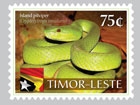 The Island pitviper, so named because of the twin heat-sensitive “pits” on its face, is the only front-fanged venomous land snake currently known to occur in Timor-Leste. Achieving lenghts of up to 1.0 m, it is widely distributed in the lowlands in both the north and south of the country, and relatively commonly encountered. Its muscular physique, prehensile tail, and green coloration may suggest an arboreal existence but this pitviper may just as easily be found on the ground, hunting amphibians or small mammals. This may be because Timor does not possess any strictly terrestrial pitvipers, such as occurs elsewhere in the Indo-Malayan Archipelago, and the pitviper does not have any competitors. Although snakebites seem to be fairly infrequent in Timor-Leste, this species has caused occasional fatalities elsewhere in its Lesser Sunda Island range, so it should be treated with respect and close encounters avoided.
The Island pitviper, so named because of the twin heat-sensitive “pits” on its face, is the only front-fanged venomous land snake currently known to occur in Timor-Leste. Achieving lenghts of up to 1.0 m, it is widely distributed in the lowlands in both the north and south of the country, and relatively commonly encountered. Its muscular physique, prehensile tail, and green coloration may suggest an arboreal existence but this pitviper may just as easily be found on the ground, hunting amphibians or small mammals. This may be because Timor does not possess any strictly terrestrial pitvipers, such as occurs elsewhere in the Indo-Malayan Archipelago, and the pitviper does not have any competitors. Although snakebites seem to be fairly infrequent in Timor-Leste, this species has caused occasional fatalities elsewhere in its Lesser Sunda Island range, so it should be treated with respect and close encounters avoided.
Timor Monitor Varanus timorensis
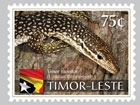 The Timor monitor achieves a maximum lenght of less than 0.7 m including its tail, which is almost twice the lenght of the body. This is especially small when compared to some of its relatives, such as the Komodo dragon (Varanus komodoensis) that lives only a short distance to the northwest in the Lesser Sundas. The Timor monitor is an elongate-bodied lizard with powerful, clawed limbs, and a long prehensile tail. It is extremely arboreal and closely related to tree monitors from Australia and New Guinea although this species is confined to Timor and the neighboring islands of Roti and Sawu. Prey consists of smaller lizards and large invertebrates. Timor monitors are most frequently encountered in coastal habitats, near palms and other trees, wich provide them with routes for rapid escape. Patterning is typical of tree monitors, with dark-edged, light-centered rosettes on a light brown background.
The Timor monitor achieves a maximum lenght of less than 0.7 m including its tail, which is almost twice the lenght of the body. This is especially small when compared to some of its relatives, such as the Komodo dragon (Varanus komodoensis) that lives only a short distance to the northwest in the Lesser Sundas. The Timor monitor is an elongate-bodied lizard with powerful, clawed limbs, and a long prehensile tail. It is extremely arboreal and closely related to tree monitors from Australia and New Guinea although this species is confined to Timor and the neighboring islands of Roti and Sawu. Prey consists of smaller lizards and large invertebrates. Timor monitors are most frequently encountered in coastal habitats, near palms and other trees, wich provide them with routes for rapid escape. Patterning is typical of tree monitors, with dark-edged, light-centered rosettes on a light brown background.
Timor Bronzeback Dendrelaphis inornatus timorensis
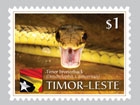 The bronzeback belongs to a very widely distributed genus containing almost 30 species occuring from India to northern Australia. Bronzebacks, as the Asian species are known, or treesnakes, as they are called in Australo-Papua, are highly alert, fast-moving, diurnal snakes with large eyes, slender bodies and long tails. The Timor bronzeback is the eastern subspecies of the Lesser Sunda bronzeback, and it also occurs on neighboring islands from Roti to Wetar. Despite its brave, even fearsome display, this snake is perfectly harmless, it feeds on frogs and small lizards and is nonvenomous.
The bronzeback belongs to a very widely distributed genus containing almost 30 species occuring from India to northern Australia. Bronzebacks, as the Asian species are known, or treesnakes, as they are called in Australo-Papua, are highly alert, fast-moving, diurnal snakes with large eyes, slender bodies and long tails. The Timor bronzeback is the eastern subspecies of the Lesser Sunda bronzeback, and it also occurs on neighboring islands from Roti to Wetar. Despite its brave, even fearsome display, this snake is perfectly harmless, it feeds on frogs and small lizards and is nonvenomous.
Saltwater Crocodile Crocodylus porosus
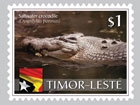 The largest living reptile in the world is distributed from India to northern Australia and includes the rivers, coastal lagoons, and costlines of Timor-Leste in its range. Achieving lenghts on excesso of 6.0. m, the saltwater crocodile, also known as estuarine crocodile and Indo-Pacific crocodile, is one of the few living reptiles that considers humans as prey. Yet despite occasional crocodile attacks in Timor-Leste, this huge animal is greatly respected because it is strongly associated with the folklore of the island of Timor. In the island’s origin myth, it was a crocodile that turned itself into Timor after an adventure at sea with a boy who saved its life. Saltwater crocodiles may be encountered in the lower reaches of any of the larger rivers in Timor-Leste but they seem most common in the quieter rivers to the east of Dili or along the south coast. Although the exact size of the population has not been ascertained it does not seem to be endangered as it is some other parts of its range.
The largest living reptile in the world is distributed from India to northern Australia and includes the rivers, coastal lagoons, and costlines of Timor-Leste in its range. Achieving lenghts on excesso of 6.0. m, the saltwater crocodile, also known as estuarine crocodile and Indo-Pacific crocodile, is one of the few living reptiles that considers humans as prey. Yet despite occasional crocodile attacks in Timor-Leste, this huge animal is greatly respected because it is strongly associated with the folklore of the island of Timor. In the island’s origin myth, it was a crocodile that turned itself into Timor after an adventure at sea with a boy who saved its life. Saltwater crocodiles may be encountered in the lower reaches of any of the larger rivers in Timor-Leste but they seem most common in the quieter rivers to the east of Dili or along the south coast. Although the exact size of the population has not been ascertained it does not seem to be endangered as it is some other parts of its range.










































